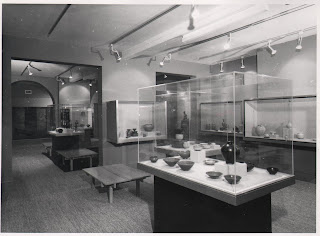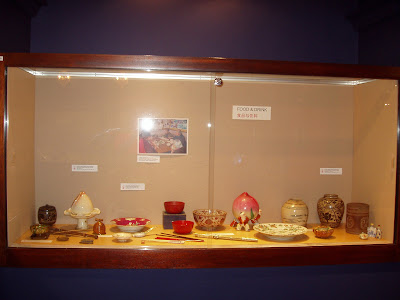Having decided to create a pawnbroker's shop within the Victorian streets when the museum was refurbished in 2001, we did not at the time have a genuine pawnbroker sign within the collections and the iconic golden balls emblem was recreated by the designers. We were delighted then this year to be offered the real thing by Stewart and Michael Manning, sons of the last owner of Zermansky's pawnbrokers on North Street. These were officially unveiled in their new position at Abbey House museum on Sunday 25th November, together with a plaque acknowledging the donation in memory of Pearl and Cyril Manning.
Finding the most appropriate wording for the plaque and our press release has been a very careful exercise in trying to avoid innuendo, with many references to balls and pawn shops!
As a museum it is always our aim to display genuine objects and it was interesting to find that the replica ones we have just replaced turned out to have been made from plastic toilet ballcocks.
Zermansky's pawnbrokers business was set up by the donor's grandfather, Mark Zermansky in about 1920 and was a fixture on North Street for most of the last century. The 1974 Consumer Credit Act put an end to the pawnbroking side of the business (it involved too much extra paperwork), but they continued as jewellers until 1981. Both Stewart and Michael Manning remember helping out in the shop.
The museum has decided not to change the name of the pawnbroker's shop display at Abbey House to Zermansky's because the streets are displayed to represent the 1890s, and Zermansky's only opened in the 1920s. T.A. Sowry & Son was a pawnbroking business with branches in Holbeck, New Wortley and Armley in the late 19th century. Pawnbrokers offered short-term loans against the value of any object and this helped many Victorians get through the week until pay day. Some were reputed to be in the habit of pawning their Sunday suit on Monday and redeeming it on Friday when the wages came in. There has been a recent resurgence in the pawnbrokers on the high street which reflects the current economic climate.
The symbolism of the pawnbroker's three golden balls is shrouded in mystery and speculation. It seems to have originally been based on a heraldic emblem of three money bags which was used by the Medici banking family in Florence. There is also an unproven seasonal link to Christmas! St Nicholas (who has mutated into Santa Claus) is said in one legend to have persuaded a family not to sell their three daughters into prostitution by posting three bags of gold down their chimney. Because of this, St Nicholas is the patron saint of pawnbrokers. This is also the suggested origin to the notion that Santa Claus brings gifts down the chimney at Christmas.
 |
| Shop on North Street, 1980 |
Kitty Ross, 30th November 2012



















